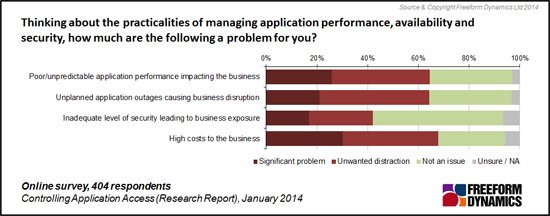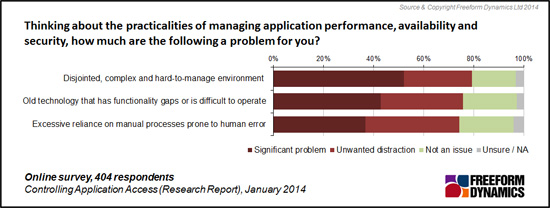By Tony Lock
The challenges placed on IT daily grow more demanding. In addition to the business user demands for access to new applications and services with minimal time to plan and make these operational, end user expectations reflect the desire to access systems from wherever they are, using any device they want, at whatever time they wish. This is forcing IT to consider how to deliver services securely.
One factor common to most application performance and security challenges can be found in enterprise networks which connect users and business operations to the IT systems on which they depend. A recent study by Freeform Dynamics examined whether network infrastructures deployed in organisations today are capable of supporting changing work patterns and evolving to address existing as well as emerging security threats.
When asked about the practicalities of managing networks which support modern business solutions, the high cost to business was the most widely reported problem. Some of these reflect direct costs such as the management overhead on IT and operations. In addition, the experience of many shows that the scale of potential indirect costs following-on from business interruptions, lost productivity and business can often exceed the direct IT financial expense (Figure 1).
Figure 1
On the technical side, a majority of respondents highlight challenges with respect to application performance are negatively impacting business operations. Once again Figure 1 shows that it is not only poor performance that is a concern, but also ‘unpredictable’ performance.
‘Security’ is always in the thoughts of IT and network managers. Yet Figure 1 indicates that fewer see this to be a challenge compared to performance management and availability. One explanation for this could simply be the natural disinclination of IT professionals to acknowledge problems in this area. It can be difficult to openly acknowledge security concerns when you are responsible for ensuring IT security.
Whilst enterprise networks may be more complex in larger organisations than in smaller business, further Freeform Dynamics analysis revealed that the challenges highlighted in Figure 1 are common across organisations of all sizes. This may reflect that larger organisations have dedicated teams to manage networks while smaller operations rely on IT generalists who have much less specialised networking skills and experience.
Despite the obvious importance of enterprise networks, the survey found a majority of organisations face significant problems or unwanted challenges managing application performance and security. Top of the list, unsurprisingly to anyone who has worked in IT, nearly four out of five respondents reported they have disjointed, complex and hard to manage networks (Figure 2).
Figure 2
Figure 2 also shows that many organisations have networks built with elements of old technology which has gaps in the functionality it provides or which is simply hard to administer. An equally large proportion indicates they are excessively dependent on manual processes which are, by their very nature, prone to human error.
A recognition of the capability holes, combined with the vital importance networks now play in everyday business, means many organisations are looking to improve application performance, availability and security capabilities (Figure 3).
Figure 3
Figure 3 reveals that few organisations have comprehensive facilities to manage performance and availability in enterprise networks. Capability shortfalls are evident across the board. A majority of organisations state improving their management capabilities across these domains is a focus of their attention.
For anyone familiar with experience of enterprise networking it is clear that moving from the disjointed networks common today to a more joined up future-proof application access infrastructure is complex. Indeed, modifying any corporate network is akin to rebuilding an aeroplane during a flight in a thunderstorm.
Given the focus on improving capabilities shown above, the survey identified a number of triggers which are likely to initiate network modernisation. Such triggers include existing equipment reaching end of life, the need to implement significant upgrades to business applications as well as higher expectations from customers, partners and suppliers.
The challenge is less to add individual capabilities and more about ensuring that the foundations are put in place to deliver a coherent network, which is able to meet escalating security availability and performance requirements going forwards. Add in the requirement to support securely new mobile working patterns, should mean that making a business case to improve network capabilities will be straightforward.
To summarise, the report highlights that the business environment is in a state of rapid flux. There is now a requirement to re-think all of the performance, availability and security aspects of application access. Existing network architectures technology and management procedures are no longer ‘good enough’.
The onus today is to find ways to modify existing corporate networks in ways that build on existing solutions yet also facilitate taking a more radical ‘data / service centric approach. Now is the time to investigate how to evolve, rather than waiting until changes are forced upon IT (which has the danger that it will do little to decrease existing fragmentation or management problems).

Tony is an IT operations guru. As an ex-IT manager with an insatiable thirst for knowledge, his extensive vendor briefing agenda makes him one of the most well informed analysts in the industry, particularly on the diversity of solutions and approaches available to tackle key operational requirements. If you are a vendor talking about a new offering, be very careful about describing it to Tony as ‘unique’, because if it isn’t, he’ll probably know.






Have You Read This?
Generative AI Checkpoint
From Barcode Scanning to Smart Data Capture
Beyond the Barcode: Smart Data Capture
The Evolving Role of Converged Infrastructure in Modern IT
Evaluating the Potential of Hyper-Converged Storage
Kubernetes as an enterprise multi-cloud enabler
A CX perspective on the Contact Centre
Automation of SAP Master Data Management